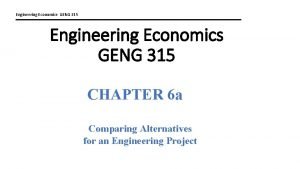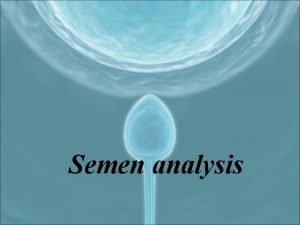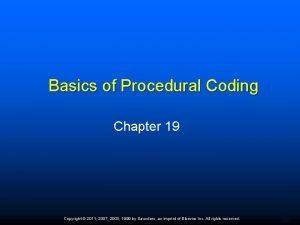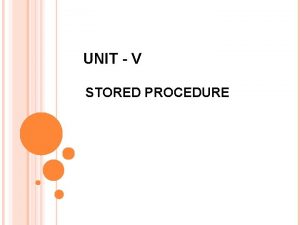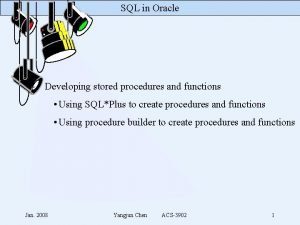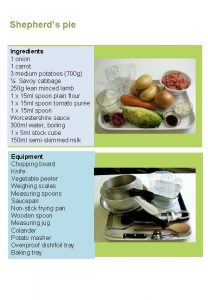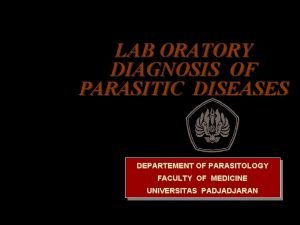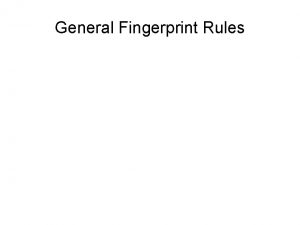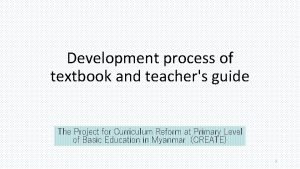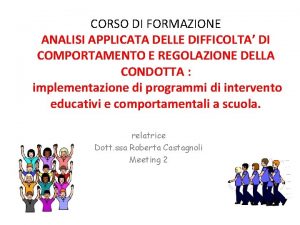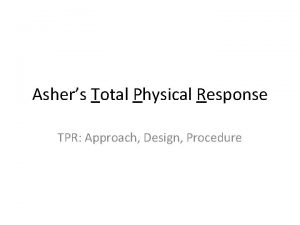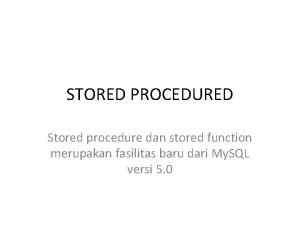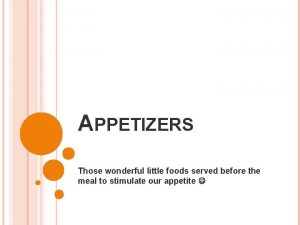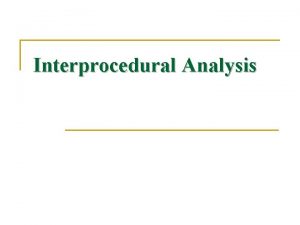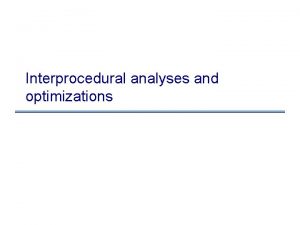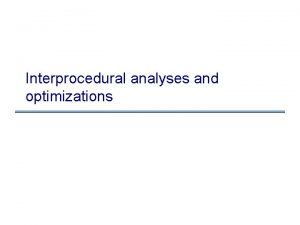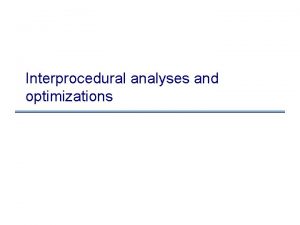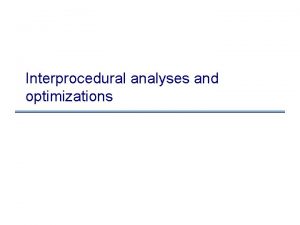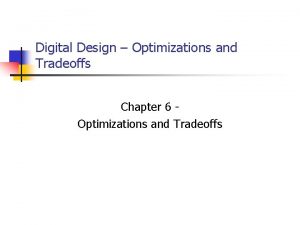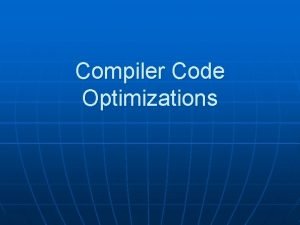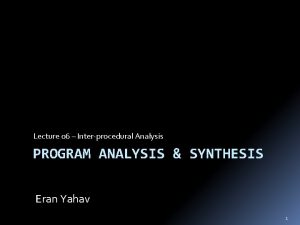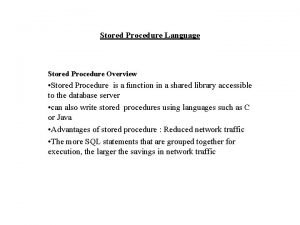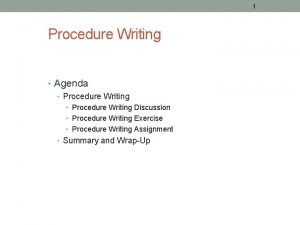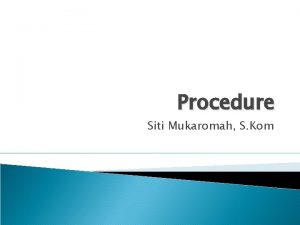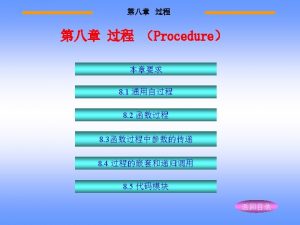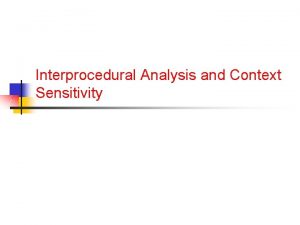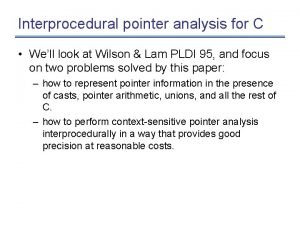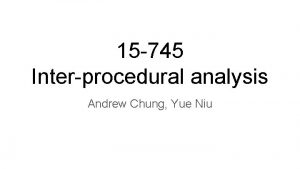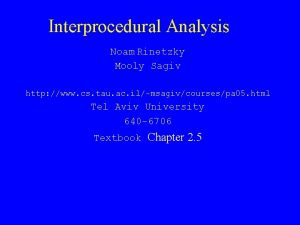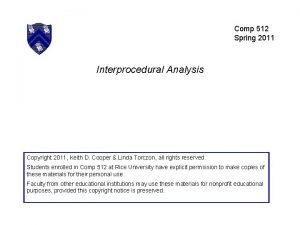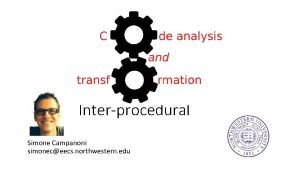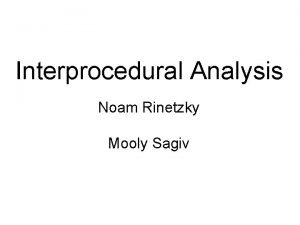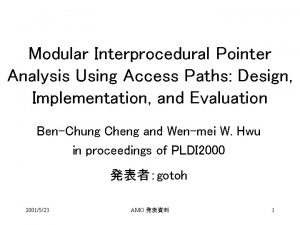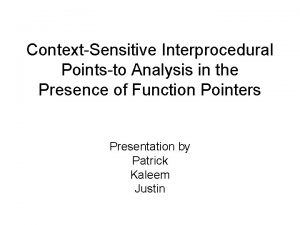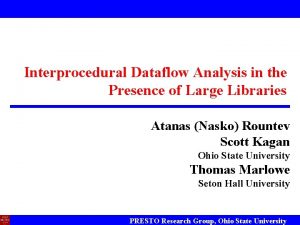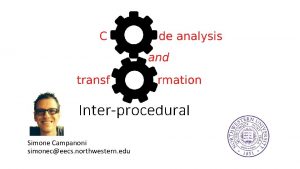Procedure Optimizations and Interprocedural Analysis Chapter 15 19















![Pascal Example with value parameters type vector = array[1… 1000] of integer procedure p(v: Pascal Example with value parameters type vector = array[1… 1000] of integer procedure p(v:](https://slidetodoc.com/presentation_image_h/1f775d44af2a835dbbcf738e840a8a13/image-16.jpg)












- Slides: 28

Procedure Optimizations and Interprocedural Analysis Chapter 15, 19 Mooly Sagiv

Outline • • Modularity Issues Procedure optimizations Interprocedural Optimizations Challenges The Call Graph Flow insensitive information Flow sensitive information Conclusions

Modularity Issues • • • Procedures provide a mechanism for modularity Procedure bodies become smaller Machines becomes stronger Often procedures implement general algorithms How to achieve performance of a single procedure in a complex software? • Two solutions: – procedure integration/inline/tail call elimination – interprocedural analysis

Procedure Optimizations • Improve the code of a procedure – Reduce procedure overhead – Enables other intraprocedural optimizations • Examples – Tail-call elimination and Tail-Recursion elimination – Procedure integration – In-Line Expansion – Leaf-Routine Optimization – Shrink Wrapping

Tail-Call and Tail-Recursive Elimination void make_node(p, n) void insert_node(n, l) int n; struct node *p; struct node *l; int n; { { if (n>l->value) struct node *q; if (l->next==nil) make_node(l, n); q = malloc(sizeof(struct node)); else insert_node(n, l->next); q->next=nil; q->value=n; p->next=q; } }

Procedure Integration • Some programming languages allow user annotations (C++, ada) • How to decide when to inline: – Single vs multiple compilation units • Multiple programming languages – Intermediate level – Code improvement criteria • Call cites in nested loops – Enables other optimizations • Profiling • Constant parameters – – What about recursive procedures? Code size Cache effect and register pressure Other compiler assumptions

Typical Heuristics for Procedure Integration • • • The size of procedure body The number of calls to this procedure Is the procedure is called inside loop? Whether a call includes constant parameters? Use both static analysis and profiling (if available) • Interprcedural analysis will lead to better results

Name Capture in Procedure integration g(b, c) int b, c; { int a, d; a = b + c; f() { int a, e, d; d= b * c; a = 2; return d; a = b + c; } d = b * c; f() e = d; { int a, e; a = 2; e = g(3, 4); printf(“%dn”, a); }

In-Line Expansion • Substitute low level code (assembly level) • Increase opportunity for using machine capabilities • Poor man’s procedure integration • Two essential mechanisms: – Define templates of machine sequences – A compiler inliner

Leaf-Routine Optimization • Do not call other routines • In practice half of the routines! • Eliminate prolog and epilog

Shrink Wrapping • Move prolog and epilog into the place where it is necessary or remove • The general idea – Move prolog forward – Move epilog backward • Requires data-flow analysis

Shrink Wrapping (Example) save r 8 -r 15 r 2 <= 10 Y N r 1 + 1 r 8 r 2 – 1 r 8 + 2 r 1 + r 2 restore r 8 -r 15

Wrap-Up (Chapter 15) • • Whole procedure optimization Applied early Allows other optimization Most do not require data-flow analysis

Interprocedural Optimizations • Can be used for procedure integration • Constant propagation can be used to optimize procedure bodies • Constant propagation can be used to “clone” procedures • Call-by-value parameters can be passed by reference (if they don’t change) • Register allocation • Improve intraprocedural information

char * Red = “red”; char * Yellow = “yellow”; char * Orange = “orange”; char * color(FRUIT Current. Fruit); { switch (current. Fruit->variety) { main() { FRUIT snack; case APPLE: return Red; VARIETY t 1; SHAPE t 2; COLOR t 3; break; t 1 = APPLE; case BANANA: return Yellow; t 2 = ROUND; break; switch (t 1) { case ORANGE: return Orange; }} case APPLE: t 3= Red; main() { FRUIT snack; break; case BANANA: t 3=Yellow; snack. variety = APPLE; snack. shape = ROUND; printf(“%sn”, color(&snack)); } break; case ORANGE: t 3=Orange; }} printf(“%sn”, t 3); }
![Pascal Example with value parameters type vector array1 1000 of integer procedure pv Pascal Example with value parameters type vector = array[1… 1000] of integer procedure p(v:](https://slidetodoc.com/presentation_image_h/1f775d44af2a835dbbcf738e840a8a13/image-16.jpg)
Pascal Example with value parameters type vector = array[1… 1000] of integer procedure p(v: vector); procedure q; var a: vector; p(a);

C Example For Constant Propagation int g; p() { … } q(){ … g=100; p(); y = g;

Challenges in Interprocedral Analysis • Handling recursion • Parameter passing mechanisms • Hidden calls – – Virtual methods Function pointers Procedural parameters Higher order functions • Scalability • Supporting separate compilation mode

The Call Graph • • A finite directed multi-graph A node per procedure A labeled edge per call site Can be constructed incrementally to support separate compilation mode • Difficult to construct in the presence of hidden calls

Example for Call Graph Construction 1: void f() { 2: g(); 3: g(); 4: h(); } 5: void g() { 6: h(); 7: i(); } 8: void h() {} 9: void i() { 10: g() ; }

Obstacles • • Procedural parameters (P-SPACE hard) Higher order functions Virtual methods Solutions – Conservative approximation – Data-Flow information – Specialization

Flow insensitive side effect analysis • Ignore control flow • Compute for every call site: – MOD - the variables that may be modified – DEF - the variables must be defined – USE - the set of variables that may be used before set • Can be computed efficiently for programs with small number of parameters (Cooper & Kennedy) • Can be used for: – program understanding – replacing value by reference parameter – improving intraprocedural information • Becomes tricky with nesting and aliases

program test; var a. b: integer; procedure g(var f 1: integer) begin 1: f 1 : = f 1 + 1; end procedure f(var f 2, f 3: integer) begin 2: g(f 2); 3: f 3 : = f 2 ; 4: g(f 3); end begin (* main) 5: a : = 5; 6: f(a, b); end.

program test; var a. b: integer; procedure g(var f 1: integer) begin 1: f 1 : = f 1 + 1; end procedure f(var f 2, f 3: integer) begin 2: g(f 2); 3: f 3 : = f 2 ; 4: g(f 3); end begin (* main) 5: a : = 5; 6: f(a, b); end.

Flow insensitive “points-to” analysis • Analyze C pointers • Find if a pointer “a” may-point to a pointer “b” • Efficient conservative solutions exit a = &x; b = & y; if (…) y = & z; else y = &x; c = &y ; *c = t ;

Flow Sensitive Data-Flow Information • Integrate control flow graph and call graph (the program supergraph) • In the presence of reference parameters even bit vector problems are hard • Two main solutions: – call strings – functional • Scaling is an issue

Non trivial constants int x void p(int a) { int c; scanf(“%d”, &c); if (c > 0) { a = a -2; p(a); a : = a +2; } x : = -2 * a + 5 printf(“%sn”, x); } void main() { p(7); printf(“%sn”, x) ; }

Conclusion • Interprocedural analysis will be integrated into future compilers • Can be implemented at link time – Register allocation • Will lead to simpler programming • Flow insensitive analysis scales • But what about flow sensitive?
 Data collection procedures
Data collection procedures Engineering economic analysis procedure
Engineering economic analysis procedure Chapter 23 milady review questions
Chapter 23 milady review questions Target needs analysis
Target needs analysis Asthenozoospermia
Asthenozoospermia Thematic analysis in qualitative research
Thematic analysis in qualitative research The six sections of the cpt manual include
The six sections of the cpt manual include Difference between procedure and function in sql
Difference between procedure and function in sql Difference between procedure and function in sql
Difference between procedure and function in sql Onion chart excel
Onion chart excel Clove hitch restraint definition
Clove hitch restraint definition Brecker cronkite method
Brecker cronkite method New hire policy and procedure
New hire policy and procedure Kato-katz and kato thick procedure
Kato-katz and kato thick procedure Kato miura method
Kato miura method Work instruction management system
Work instruction management system Procedure of welcoming the guest
Procedure of welcoming the guest Mould loading and unloading procedure
Mould loading and unloading procedure Delta and core
Delta and core Schachter and singer aim
Schachter and singer aim Difference between policy and procedure
Difference between policy and procedure Soap making ingredients and procedure
Soap making ingredients and procedure Process of textbook designing and development
Process of textbook designing and development Count and mand procedure
Count and mand procedure Tpr
Tpr Stored subprogram adalah?
Stored subprogram adalah? Appetizer recipes with ingredients and procedure
Appetizer recipes with ingredients and procedure Ibrahim askar
Ibrahim askar Patient identification and procedure matching
Patient identification and procedure matching

